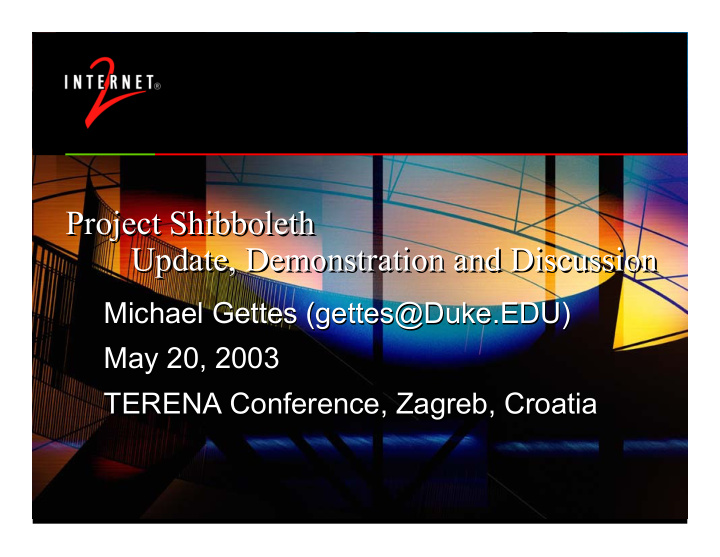



Project Shibboleth Project Shibboleth Update, Demonstration and Discussion Update, Demonstration and Discussion Michael Gettes (gettes@Duke.EDU) Michael Gettes (gettes@Duke.EDU) May 20, 2003 May 20, 2003 TERENA Conference, Zagreb, Croatia TERENA Conference, Zagreb, Croatia
Shibboleth A word which was made the criterion by which to distinguish the Ephraimites from the Gileadites. The Ephraimites, not being able to pronounce sh, called the word sibboleth. See -- Judges xii. Hence, the criterion, test, or watchword of a party; a party cry or pet phrase. - Webster's Revised Unabridged Dictionary (1913): 2
Stage 1 - Addressing Three Scenario’s Member of campus community accessing licensed resource • Anonymity required Member of a course accessing remotely controlled resource • Anonymity required Member of a workgroup accessing controlled resources • Controlled by unique identifiers (e.g. name) Taken individually, each of these situations can be solved in a variety of straightforward ways. Taken together, they present the challenge of meeting the user's reasonable expectations for protection of their personal privacy. 3
Establishing a User Context 4
Getting Attributes and Determining Access 5
Shibboleth Architecture 6
Shibboleth Architecture -- Managing Trust TRUST Attribute Shib Server engine Target Browser Web Server Target Site Origin Site 7
Milestones Project formation - Feb 2000 Stone Soup Process - began late summer 2000 with bi-weekly calls to develop scenario, requirements and architecture. Linkages to SAML established Dec 2000 Architecture and protocol completion - Aug 2001 Design - Oct 2001 Coding began - Nov 2001 Alpha-1 release – April 24, 2002 OpenSAML release – July 15, 2002 v0.7 Shibboleth released Nov 25, 2002 v0.8 March 1, 2003 v1.0 May 2003 (end of month) v1.1 conversations ruminating; v1.2 may be the plateau 8
Code status v0.8 released March 2003 (coding teams – MIT, Columbia, Ohio State, CMU); v1.0 due out April 10 v0.7 much easier to install than alpha’s. C/C++ only on origin. Java still on target. Relatively safe to deploy and experiment Release issues – platform dependencies, fragile Apache components, binaries vs source, etc… v0.7 to v0.8 new features – ARP’s redone, added robustness timeframes – march 1, 2003 general release V0.8 to 1.0 – SAML 1.1 support, bug fixes and re-packaging 9
Course Management Early Adopters WebCT Webassign Blackboard (Demonstrated April, 2003) OKI 10
The Library Pilots • Explore and Evaluate the utility of the Shibboleth model (attributes) for controlling access to licensed resources • Identify problems and issues with this approach • How well do existing licenses map to attributes? • Library “walk-in” customers • Identify and address Shib deploy issues for campuses AND for vendors • Explore new possibilities, including role-based access controls 11
Campus Participants Carnegie Mellon Penn State Columbia U. Colorado Dartmouth U. Michigan Georgetown U. Washington London School of Economics U. Wisconsin - Madison New York Unv. UCOP (U. California System) Ohio State U.Texas Health Science Center at Houston Others coming on 12
Vendor Participants EBSCO ~ Elsevier OCLC Sfx (Ex libris) JSTOR McGraw Hill eBooks Innovative (III) Consortial efforts: WRLC, Athens, … 13
Shibboleth Deployment Issues Access Issues Kiosks and walk-ins logins for on-campus use Licensing issues reconciling license structures with directory structures system and consortial issues mitigating disintermediation Functional issues handling Shibbed and non-Shibbed resources roll-out strategies entitlements vs attributes what attributes to pass how to structure the attribute name space 14
A Quick Demonstration Shib Demo Site 15
Next steps Convergence with other efforts (PAPI, Permis, A-Select, etc) Shibboleth used as a WebISO solution, the N-Tier problem What is a Federation? How do we define it? Sub-Fed, Fed Clusters, Super Federations Shibboleth the architecture vs Shibboleth the web service Shibboleth the technology vs Club Shib the trust model Federated Digital Rights Management Federated P2P Privacy Management Systems – see http://www.ischool.washington.edu/shibbui/index.html Personal Information Managers – see http://www.brown.edu/cgi- bin/httool.epl 16
Personal Resource Manager 17
Privacy Management Systems 18
Overall Trust Fabric 19
Recommend
More recommend